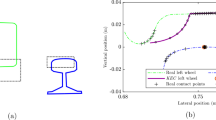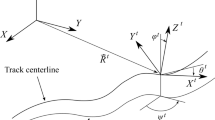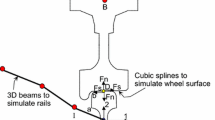Abstract
In this investigation, four nonlinear dynamic formulations that can be used in the analysis of the wheel/rail contact are presented, compared and their performance is evaluated. Two of these formulations employ nonlinear algebraic kinematic constraint equations to describe the contact between the wheel and the rail (constraint approach), while in the other two formulations the contact force is modeled using a compliant force element (elastic approach). The goal of the four formulations is to provide accurate nonlinear modeling of the contact between the wheel and the rail, which is crucial to the success of any computational algorithm used in the dynamic analysis of railroad vehicle systems. In the formulations based on the elastic approach, the wheel has six degrees of freedom with respect to the rail, and the normal contact forces are defined as function of the penetration using Hertz’s contact theory or using assumed stiffness and damping coefficients. The first elastic method is based on a search for the contact locations using discrete nodal points. As previously presented in the literature, this method can lead to impulsive forces due to the abrupt change in the location of the contact point from one time step to the next. This difficulty is avoided in the second elastic approach in which the contact points are determined by solving a set of algebraic equations. In the formulations based on the constraint approach, on the other hand, the case of a non-conformal contact is assumed, and nonlinear kinematic contact constraint equations are used to impose the contact conditions at the position, velocity and acceleration levels. This approach leads to a model, in which the wheel has five degrees of freedom with respect to the rail. In the constraint approach, the wheel penetration and lift are not permitted, and the normal contact forces are calculated using the technique of Lagrange multipliers and the augmented form of the system dynamic equations. Two equivalent constraint formulations that employ two different solution procedures are discussed in this investigation. The first method leads to a larger system of equations by augmenting all the contact constraint equations to the dynamic equations of motion, while in the second method an embedding procedure is used to obtain a reduced system of equations from which the surface parameter accelerations are systematically eliminated. Numerical results are presented in order to examine the performance of various methods discussed in this study.
Similar content being viewed by others
References
De Pater, A. D., ‘The geometrical contact between track and wheel set’, Vehicle System Dynamics 17, 1988, 127–140.
Simeon, B., Fuhrer, C., and Rentrop, P., ‘Differential algebraic equations in vehicle system dynamics ’, Survey on Mathematics in Industry 1, 1991, 1–37.
Kalker, J. J., ‘Survey of wheel-rail rolling contact theory’, Vehicle System Dynamics 8(4), 1979, 317–358.
Knothe, K. and Bohm, F., ‘History of stability of railway and road vehicle’, Vehicle System Dynamics 31, 1999, 283–323.
Iwnicki, S., The Manchester Benchmarks for Rail Vehicle Simulation, Swets & Zeitlinger, Lisse, The Netherlands, 1999.
Garg, V. K. and Dukkipati, R. V., Dynamics of Railway Vehicle Systems, Academic Press, Orlando, FL, 1984.
Shabana, A. A. and Sany, J. R., ‘A survey of rail vehicle track simulations and flexible multibody dynamics’, Nonlinear Dynamics 26, 2001, 179–210.
Shabana, A. A. and Sany, J. R., ‘An augmented formulation for mechanical systems with non-generalized coordinates: Application to rigid body contact problems’, Nonlinear Dynamics 24, 2001, 183–204.
Shabana, A. A., Zaazaa, E. K., Escalona, L. J., and Sany, J. R., ‘Development of elastic force model for wheel/rail contact problems’, Journal of Sound and Vibration 269, 2004, 295–325.
Shabana, A. A., Berzeri, M., and Sany, J. R., ‘Curved track modeling using the absolute nodal coordinate formulation’, Technical Report No. MBS00-4-UIC, 2000, University of Illinois at Chicago, IL.
Pombo, J. and Ambrosio, J., ‘A wheel/rail contact model for rail guided vehicles dynamics’, in Proceedings of ECCOMAS Thematic Conference on Advances in Computational Multibody Dynamics, Lisboa, Portugal, 1–4 July 2003.
Kalker, J. J., ‘Three-dimensional elastic bodies in rolling contact’, Kluwer Academic Publishers, Boston, MA, 1990.
Kalker, J. J., ‘Wheel-rail rolling contact theory’, Wear 144, 1991, 243–261.
Kik, W. and Piotrowski, J., ‘A fast approximation method to calculate normal load at contact between wheel and rail and creep forces during rolling’, in Proceedings of 2nd Mini Conference on Contact Mechanics and Wear of Rail/Wheel System, I. Zabory (ed.), TU Budapest, 1996.
Zaazaa, K., ‘Elastic force model for wheel/rail contact in multibody railroad vehicle systems’, Ph.D. Thesis, Department of Mechanical Engineering, University of Illinois at Chicago, Chicago, IL, 2003.
Author information
Authors and Affiliations
Corresponding author
Rights and permissions
About this article
Cite this article
Shabana, A.A., Tobaa, M., Sugiyama, H. et al. On the Computer Formulations of the Wheel/Rail Contact Problem. Nonlinear Dyn 40, 169–193 (2005). https://doi.org/10.1007/s11071-005-5200-y
Received:
Accepted:
Issue Date:
DOI: https://doi.org/10.1007/s11071-005-5200-y




